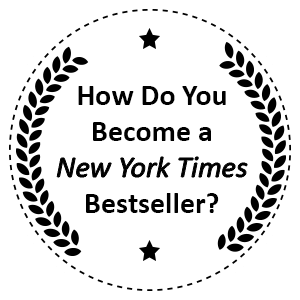How to Become a New York Times Bestseller – Becoming a Bestselling Author
 How do you become a New York Times bestseller? For most authors, becoming a bestselling author on the NYT bestseller list is the ultimate accomplishment. Not just because it’s lucrative, but because it’s validating. Appearing on the New York Times bestseller list means a lot of people like and/or respect your writing ability and/or ideas. And, if your work is meaningful, appearing on the list means you’re making a difference.
How do you become a New York Times bestseller? For most authors, becoming a bestselling author on the NYT bestseller list is the ultimate accomplishment. Not just because it’s lucrative, but because it’s validating. Appearing on the New York Times bestseller list means a lot of people like and/or respect your writing ability and/or ideas. And, if your work is meaningful, appearing on the list means you’re making a difference.
This article explains the criteria used to determine which authors appear on the list. It also reveals what you can do to increase your chances of becoming a New York Times bestseller. This article is part of a series about how to become a bestselling author, written by a former literary agent who’s helped 400+ authors get literary agents and/or traditional publishers.
Becoming a New York Times bestseller requires significant sales within any given week of the year, from a variety of retailers: large chains, online sellers, and independent bookstores. Traditionally published books are more likely to appear on the New York Times bestseller list, since self-published authors don’t usually have broad enough distribution.
How Do You Become a New York Times Bestseller?
Becoming a New York Times bestselling author is a pinnacle achievement in the literary world. The title carries prestige, professional recognition, and the promise of increased book sales. However, earning this coveted status is not as straightforward as just selling a lot of books. It requires a strategic combination of excellent writing, smart marketing, and understanding the intricacies of the New York Times bestseller list. Here’s a comprehensive guide to achieving this milestone.
1. Understand the Criteria for the List
The New York Times bestseller list is curated and does not rely solely on raw sales numbers. Several factors influence whether a book qualifies:
- Sales Across Vendors: The list accounts for books sold across a variety of outlets, including independent bookstores, chain retailers, and online platforms. Concentrated sales from a single source may not count as heavily.
- Diversity of Sales Channels: Books that sell across different regions and through multiple channels are more likely to be included.
- Timeframe: Sales within the first week of a book’s release are particularly crucial.
- Format and Category: The Times divides books into categories like hardcover fiction, nonfiction, children’s, and graphic novels, with separate lists for each.
2. Choose the Right Publishing Path
Your publishing approach plays a significant role in positioning your book for the New York Times list.
- Traditional Publishing: Offers access to established distribution networks, bookstores, and media coverage, increasing your chances of widespread sales.
- Self-Publishing: While less common on the Times list, self-published books with significant sales across multiple platforms can qualify.
- Hybrid Publishing: Combines elements of traditional and self-publishing, allowing authors some control while leveraging professional distribution.
3. Develop a Compelling Book
A great book is the foundation of success. To stand out, your book should:
- Have a Strong Hook: Your premise should be unique, marketable, and instantly engaging.
- Appeal to a Target Audience: Know who your readers are and write with them in mind.
- Exhibit Quality Writing: Invest in professional editing and formatting to ensure your book meets industry standards.
4. Build Buzz Before the Release
Pre-launch marketing is critical for creating anticipation and securing pre-orders, which count toward first-week sales.
- Leverage Social Media: Share behind-the-scenes content, teasers, and updates to engage potential readers.
- Secure Pre-Orders: Encourage readers to pre-order your book through diverse channels, as these sales contribute significantly to bestseller rankings.
- Collaborate with Influencers: Partner with bloggers, reviewers, and social media influencers to amplify your reach.
5. Word-of-Mouth and Reader Reviews
Word-of-mouth is one of the most powerful drivers of book sales. When readers love a book, they recommend it to friends, share it on social media, and leave glowing reviews on platforms like Amazon and Goodreads. Positive buzz can propel a book from steady sales to bestseller status.
6. Maximize Launch Week Sales
The first week of sales is the most important period for hitting the bestseller list. Strategies include:
- Host Launch Events: In-person or virtual book launches can generate excitement and drive sales.
- Run Promotions: Offer limited-time discounts or bundles to incentivize purchases.
- Media Outreach: Secure interviews, features, and reviews to increase visibility.
- Tap Into Networks: Mobilize your personal and professional network to spread the word about your book.
7. Secure Wide Distribution
To qualify for the New York Times list, your book needs to be available in diverse formats and through multiple channels:
- Print and Digital Formats: Ensure your book is available as a hardcover, paperback, ebook, and audiobook.
- Retail Presence: Partner with distributors to place your book in physical stores and libraries, in addition to online platforms.
- Independent Bookstores: Strong sales in independent bookstores are weighted heavily by the Times.
8. Understand the Role of Bulk Sales
While bulk purchases can boost sales, the New York Times has policies to discount large, concentrated sales from counting toward the list. Spread your bulk sales across various channels and regions to ensure they are counted fairly.
9. Maintain Momentum Post-Launch
Even if you don’t hit the list immediately, sustained sales can keep your book in contention for subsequent weeks. Strategies include:
- Engage With Readers: Continue interacting with your audience through book clubs, Q&A sessions, and social media.
- Promote Media Appearances: Share interviews and features to attract new readers.
- Offer Ongoing Promotions: Run periodic sales or giveaways to keep interest high.
10. The Element of Luck
Finally, luck often plays a role in a book’s success. Unexpected factors—like a celebrity endorsement, a viral social media post, or unforeseen cultural relevance—can catapult a book onto bestseller lists seemingly overnight.
Conclusion – How to Become a New York Times Bestseller
Becoming a New York Times bestselling author requires a blend of exceptional writing, strategic planning, and effective marketing. By understanding the list’s criteria, building anticipation, and maximizing your book’s reach, you can position yourself for success. While the path is challenging, the rewards—both personal and professional—make the effort worthwhile. Now that you’ve read “How to Become a New York Times Bestselling Author,” click here to make sure you’ve seen everything else in our guide about how to become a bestselling author.

Support Center (browse the tabs)
- See Our Websites
- Search Our Websites
- Free Resources
- Reviews
- Send Us a Message
- Speak with Us
- Schedule a 1-On-1 Coaching/Consulting Session
Use our search box at the top of your device screen to find what you're looking for--instantly. Our search tool will display relevant content to your search from every one of our websites.
Enter your first name and email address in the form above for instant access to all our resources to help you become the bestselling author you can be:
- Advice from Bestselling Authors (text and audio)
- Access to the Official Directory of Book Agents
- Literary Agent Advice (text and audio)
- Insider Articles and Updates
Fiction/Novels
BIPOC Fiction - H. August
Christian Fiction - K. Sargent
Crime/Mystery Fiction - B. Harper
Mystery/Thriller Fiction - J. Brown
General/Upmarket Fiction - J. Jago
General Fiction - K. Cox
Thriller Fiction - C. LePort
Memoir/Autobiography
Addiction/Recovery - M. Bond
Animals/Inspirational - K. Finley
BIPOC/Inspirational - D. Tolson
BIPOC/Inspirational - L. Subramani
BIPOC/Inspirational - N. Aronheim
Christian/Inspirational - S. LeRette
Family/Identity/Holocaust - S. Foti
Women's/Mainstream - E. Armstrong
Authors: Having trouble finding something on our websites, or have a question? We're happy to help. Send Us a Message here.
Literary Agents: To update your profile on one of our websites, or to have us consider adding your information to our websites, Send Us an Email here.
Event Coordinators: To invite us to speak at an event, Send Us an Email here.
Media: To interview or quote us or one of our authors, Send Us an Email here.
If you want to schedule a 1-on-1 session to get support related to your publishing goals, click here to see if a Literary Agent Advice consultation is a fit for you.
For all other questions or requests, Send Us a Message here.
We provide 1-on-1 coaching and consulting to both new and established authors of all book genres, in the United States and abroad. Our main focus (400+ success stories) is helping authors get offers from literary agents and/or traditional publishers.
Support areas:
- Book Development
- Query Letter
- Book Synopsis
- Book Proposal
- Author Platform
- Agent Selection
- Process/Strategy
- Troubleshooting
- Miscellaneous
Learn more about scheduling a Literary Agent Advice session.


